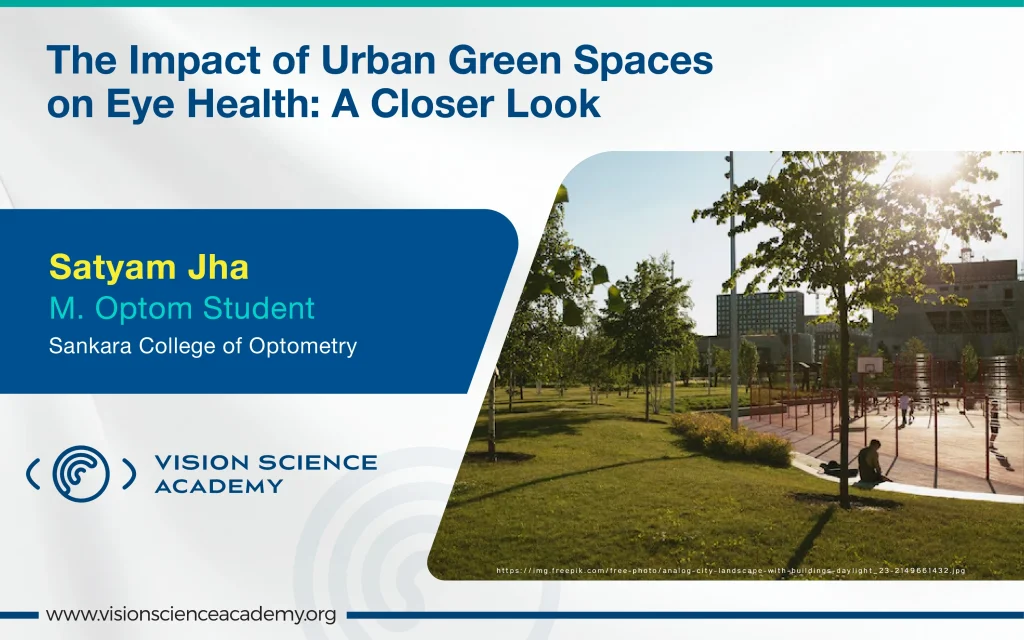Satyam Jha, FICO
M. Optom Student, Sankara College of Optometry, Ludhiana, India
In today’s fast-paced urban environments, the importance of green spaces often takes a backseat to concrete developments and infrastructure. However, recent studies highlight a compelling connection between access to urban green spaces and improved eye health and vision quality. This blog explores how these areas can significantly influence our ocular well-being. (Figure1)
The Importance of Green Spaces
Urban green spaces, such as parks, gardens, and tree-lined streets, provide more than just aesthetic appeal. They fundamentally promote physical and mental health, particularly in densely populated areas. Some key benefits include:
- Stress Reduction: Natural environments have been shown to lower stress levels, positively impacting overall health, including eye health. (1,2)
- Encouraging Outdoor Activities: Green spaces promote physical activities like walking, jogging, and cycling, which are beneficial for general health and well-being. (2)
Figure 1: Urban Green Spaces
Image Courtesy: https://www.shutterstock.com/image-photo/top-view-crop-unrecognizable-doctor-600nw-1977017900.jpg
Connection Between Green Spaces and Eye Health
- Reduction of Eye Strain: In our digital age, excessive screen time has led to increased incidences of eye strain and discomfort, commonly known as digital eye strain or computer vision syndrome. Access to green spaces can help mitigate this issue:
-
- Natural Breaks: Spending time in green spaces encourages breaks from screens, allowing the eyes to relax and refocus. This can help reduce symptoms associated with prolonged screen exposure. (1)
- Distant Viewing: Green spaces provide opportunities for distant viewing, which is essential for maintaining eye health. Activities like walking through a park or gazing at distant trees can help reduce eye fatigue. (2)
- Improved Air Quality: The presence of greenery in urban settings contributes to better air quality:
-
- Pollution Filtration: Trees and plants filter pollutants from the air, reducing particulate matter that can cause irritation and inflammation in the eyes. (2) (Figure 2)
- Reduced Allergens: Green spaces can also help mitigate allergens, such as pollen, by providing a habitat for natural predators and maintaining ecological balance. This reduction can lead to fewer allergy-related eye issues. (2)
Figure 2: Nature and Pollution
Image Courtesy: https://www.shutterstock.com/image-photo/top-view-crop-unrecognizable-doctor-600nw-1977017900.jpg
- Enhanced Mental Well-being: Mental health has a direct impact on physical health, including eye health:
-
- Stress and Eye Health: Chronic stress is linked to various eye conditions, including dry eye syndrome and glaucoma. Access to green spaces helps reduce stress levels, ultimately benefiting ocular health. (3) (Figure 3)
- Community and Social Interaction: Green spaces serve as communal areas where individuals can interact and engage in social activities, further enhancing mental well-being. (3)
Figure 3: Mental Health Enhancement
Image Courtesy: https://www.shutterstock.com/image-photo/top-view-crop-unrecognizable-doctor-600nw-1977017900.jpg
- Promoting Access to Green Spaces: Recognising the impact of urban green spaces on eye health prompts the need for improved access and integration of nature into city planning:
- Urban Planning Initiatives: City planners should prioritise green space development to ensure every resident has access to parks and nature. (4)
- Community Engagement: Encouraging local communities to participate in the maintenance and development of green spaces fosters a sense of ownership and responsibility, enhancing their effectiveness. (4)
The relationship between urban green spaces and eye health is a crucial aspect of public health that deserves more attention. Access to these natural environments can alleviate eye strain, improve air quality and bolster mental health—all contributing factors to better vision quality. As urban areas continue to grow, prioritising green spaces will be essential in promoting not only eye health but overall well-being. By recognising and harnessing the benefits of urban greenery, we can pave the way for healthier, more vibrant communities.
References:
- Akilah Davitt (2023 Feb,3) The Importance of Green Spaces in an Increasingly Gray World https://sustainable-earth.org/green-spaces/
- Andrew Chee Keng Lee, Hannah C Jordan, Jason Horsley (2015 Aug,27) Value of urban green spaces in promoting healthy living and wellbeing: prospects for planning doi: 10.2147/RMHP.S61654 https://pmc.ncbi.nlm.nih.gov/articles/PMC4556255/
- Chen Gong, Rongtian Yang, Shuhua Li (2024 May) The role of urban green space in promoting health and well-being is related to nature connectedness and biodiversity: Evidence from a two-factor mixed-design experiment https://doi.org/10.1016/j.landurbplan.2024.105020 https://www.sciencedirect.com/science/article/pii/S0169204624000203
- Danial (2023 June)10 Ways to Create Green Spaces for Cities https://www.greencitytimes.com/10-ways-to-create-green-spaces/
